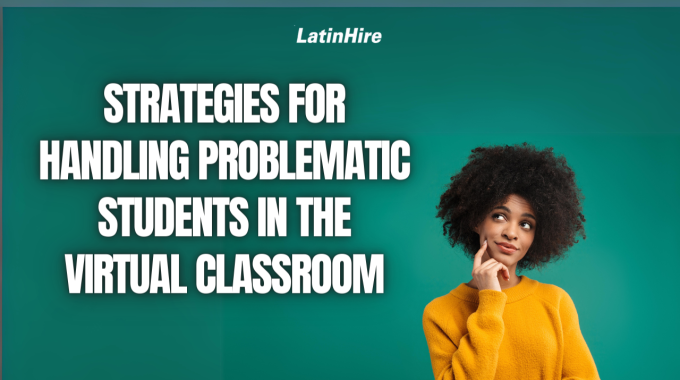Teaching English online to children is a lot more hands-on than teaching adults. It requires…

Strategies for Handling Problematic Students in the Virtual Classroom
The transition from traditional, in-person teaching to online classes comes with its own set of challenges. While online classrooms have been around for some time, many students still find it a significant adjustment. Dealing with technical issues, the absence of physical interaction, and the lack of direct supervision have posed difficulties for some in adapting to this new learning environment.
One notable challenge for educators in the online realm is dealing with problematic students. Whether it’s disruptive behavior, lack of engagement, or academic struggles, addressing these issues requires a thoughtful and proactive approach.
In this article, we’ll explore effective strategies for managing and supporting problematic students in your online classes.
1) Establish Clear Expectations
Setting clear expectations from the beginning can help create a positive online learning environment. Clearly outline your class rules, participation guidelines, and academic expectations in your syllabus. Communicate these expectations regularly and encourage students to ask questions if they are unsure. When everyone understands the ground rules, it becomes easier to address issues as they arise, since you’ll have a standard to refer to.
2) Foster Open Communication

Encourage open communication between you and your students. Create a safe space where students feel comfortable expressing their concerns or seeking clarification. Regularly check in with your students individually, either through email or virtual meetings, to understand their needs and address any challenges they may be facing. Often, students just want to know that their teacher cares and this alone can solve many problematic issues in the classroom.
3) Utilize Technology for Monitoring and Engagement
Leverage the features on your online learning platform to monitor student progress and engagement. If your teaching platform does not have these features, consider using a third-party website, such as Class Dojo, to keep track of attendance, participation, and assignment submissions. Early identification of issues allows for timely intervention.
Utilize discussion forums, polls, and interactive tools, such as Mentimeter and Kahoot, to enhance student participation. By keeping them involved in the learning process, they are less likely to cause disruption out of boredom or disengagement. When students are having fun in class, the occurrence of problematic behavior is significantly minimized.
4) Implement a Progressive Intervention Approach

At the beginning of the course, it’s essential to clearly communicate the expected behaviors in the virtual classroom. Providing students with an upfront understanding of both acceptable and unacceptable behaviors sets the tone for a positive learning environment. This proactive approach ensures everyone is on the same page and contributes to a more conducive online learning experience.
A suggestion for how to implement a progressive intervention approach is to start with gentle reminders and provide constructive feedback privately. If issues persist, escalate your intervention gradually. This may involve including parents, administrations, or implementing disciplinary actions as a last resort. Consistency in your approach is key and ensures that your students understand these are the consequences for misbehavior.
5) Offer Additional Support
Recognize that students may face challenges beyond the virtual classroom that impact their behavior or performance in class. Provide additional resources, such as study guides, Youtube videos and other websites to support their learning. Tailor your assistance to the specific needs of each student to ensure that they feel supported in overcoming obstacles.
In instances where you sense deeper issues affecting a student’s well-being or academic performance, consider guiding them to available support services. This may include recommending guidance counselors, online mental health support services, or resources within your local region (if the students live in the same area). By extending a helping hand and connecting them with appropriate support, you are fostering a caring and understanding educational environment.
6) Collaborate with Parents or Guardians

If your students are young, maintain open lines of communication with parents or guardians, especially when dealing with persistent issues. Share your observations and seek their insights into potential underlying problems. Together, you can work towards a collaborative solution that benefits the student’s overall well-being and academic success.
7) Encourage Peer Support and Collaboration
Cultivate a strong sense of community in your online class by promoting peer support and collaboration. Encourage students to work on projects, participate in group discussions, and share their knowledge. Utilize breakout rooms to facilitate small group work, allowing students to build connections with their peers.
Rotate partners in each class to ensure students get to know different members of the classroom. Positive peer interactions play a crucial role in creating a welcoming and inclusive learning environment, ultimately helping to reduce instances of problematic behaviors.
Do you have other strategies for handling problematic students in your online classes? Share them in the comments below!



